WWDC21
-
-
 1:14
1:14
Friday@WWDC21
It's time to say adieu to the week, and what a week it was! Tune in as we recap Friday and close out WWDC21.
English, Japanese, Simplified Chinese -
 106:49
106:49
Keynote
The Apple Worldwide Developers Conference kicks off with exciting reveals, inspiration, and new opportunities. Join the worldwide developer community for an in-depth look at the future of Apple platforms, directly from Apple Park.
English, French, German, Japanese, Korean, Russian, Simplified Chinese, Spanish -
 106:49
106:49
Keynote (ASL)
The Apple Worldwide Developers Conference kicks off with exciting reveals, inspiration, and new opportunities. Join the worldwide developer community for an in-depth look at the future of Apple platforms, directly from Apple Park. This version includes American Sign Language (ASL) interpretation.
English, French, German, Japanese, Korean, Russian, Simplified Chinese, Spanish -
 2:30
2:30
Monday@WWDC21
Trying to make sense of all the exciting announcements, new technologies, and Fall previews at WWDC this year? Let's break it down for you. Check out a recap of everything that happened on Day 1 of WWDC — and get a sneak peek at all the great stuff coming tomorrow.
English, Japanese -
 73:26
73:26
Platforms State of the Union
Take a deeper dive into the new tools, technologies, and advances across Apple platforms that will help you create even better apps.
English, Japanese, Korean, Simplified Chinese -
 73:26
73:26
Platforms State of the Union (ASL)
Take a deeper dive into the new tools, technologies, and advances across Apple platforms that will help you create even better apps. This version includes American Sign Language (ASL) interpretation.
English, Japanese, Korean, Simplified Chinese -
 1:16
1:16
Thursday@WWDC21
Where did the WWDC week go? We'll tell you: Check out everything you missed on Thursday and tune in for a quick preview of our final day at Dub Dub.
English, Japanese, Simplified Chinese -
 1:40
1:40
Tuesday@WWDC21
The day's almost over, but there's still so much to explore: Catch up on the best of Day 2 at WWDC and check out a few of the great sessions and activities still to come.
English, Japanese, Simplified Chinese -
 19:41
19:41
WWDC21 Apple Design Awards
The Apple Design Awards honors excellence in innovation, ingenuity, and technical achievement in app and game design. Watch along as we reveal and celebrate the 2021 winners.
English, Japanese, Simplified Chinese -
 19:41
19:41
WWDC21 Apple Design Awards (ASL)
The Apple Design Awards honors excellence in innovation, ingenuity, and technical achievement in app and game design. Watch along as we reveal and celebrate the 2021 winners. This version includes American Sign Language (ASL) interpretation.
English, Japanese, Simplified Chinese -
 1:46
1:46
Wednesday@WWDC21
Well hello, Wednesday! Time to catch up on Day 3 at WWDC and find out what's coming to a Thursday near you.
English, Japanese, Simplified Chinese
-
-
Accessibility & Inclusion -
 10:12
10:12
Accessibility by design: An Apple Watch for everyone
Discover how Apple creates products that work well for everyone. Learn from a few of the engineers and designers who helped build Apple Watch as they share stories that highlight our approach to accessible design, constant iteration, and community engagement.
Accessibility & Inclusion English -
 19:43
19:43
Bring accessibility to charts in your app
Charts are an essential tool for understanding data, and critical to understanding ourselves, our health, our finances, and our world. Find out how you can make charts accessible in your apps to people with vision impairments through audio graphs and sonified data. And we'll show you how to...
Accessibility & Inclusion English, Japanese, Simplified Chinese -
 23:26
23:26
Create accessible experiences for watchOS
Discover how you can build a top-notch accessibility experience for watchOS when you support features like larger text sizes, VoiceOver, and AssistiveTouch. We'll take you through adding visual and motor accessibility support to a SwiftUI app built for watchOS, including best practices around API...
Accessibility & Inclusion English, Japanese, Simplified Chinese -
 6:20
6:20
Developer spotlight: Accessibility
How do you approach creating apps for everyone? Learn from developers who are blind or deaf themselves as they discuss the process of making technology accessible. Discover how their unique perspectives have sparked innovation at their companies and helped make their apps even more inclusive.
Accessibility & Inclusion English -
 17:36
17:36
Localize your SwiftUI app
Learn how to localize your SwiftUI app and make it available to a global audience. Explore how you can localize strings in SwiftUI, including those with styles and formatting. We'll demonstrate how you can save time by having SwiftUI automatically handle tasks such as layout and keyboard...
Accessibility & Inclusion English, Japanese, Simplified Chinese -
 27:04
27:04
Streamline your localized strings
When you localize the text within your app, you can help make your app more accessible to a worldwide audience. Discover best practices for building your localization workflow, including how to write and format strings accurately, and learn how to prepare strings for localization in different...
Accessibility & Inclusion English, Japanese, Simplified Chinese -
 16:50
16:50
Support Full Keyboard Access in your iOS app
iPhone and iPad support numerous input modes for those with motor impairments, including touch interaction modification, Switch Control, and Full Keyboard Access. We'll explore how people can interact with their devices solely through keyboard input, working through a real-life example to...
Accessibility & Inclusion English, Japanese, Simplified Chinese -
 28:10
28:10
SwiftUI Accessibility: Beyond the basics
Go beyond the basics to deliver an exceptional accessibility experience. Learn how to use the new SwiftUI Previews in Xcode to explore the latest accessibility APIs and create fantastic, accessible apps for everyone. Find out how you can customize the automatic accessibility built into SwiftUI to...
Accessibility & Inclusion English, Japanese -
 10:26
10:26
Tailor the VoiceOver experience in your data-rich apps
Learn how to present complex data through VoiceOver with the Accessibility Custom Content API. Discover how you can deliver accessibility information in a concise form, and only when someone wants it. We'll show you how you can integrate AXCustomContent and help people who want VoiceOver enabled...
Accessibility & Inclusion English, Japanese -
 34:06
34:06
The practice of inclusive design
An inclusive app or game is not only usable by different people, but also welcomes people from diverse backgrounds and perspectives. Discover how you can design inclusive content for your interface, language, imagery, and marketing materials and support the broadest possible range of people with...
Accessibility & Inclusion English, Japanese, Simplified Chinese -
 36:34
36:34
The process of inclusive design
Discover how you can deliver inclusive apps that can foster amazing experiences for everyone who uses your software. We'll take you through best practices for creating and empowering diverse teams and explore how inclusivity influences every stage of the design and development process.
Accessibility & Inclusion English, Japanese, Simplified Chinese -
 14:40
14:40
Your guide to keyboard layout
Discover how you can use the Keyboard Layout Guide to manage how keyboards work within your iOS or iPadOS app. Learn how you can avoid writing lengthy code blocks when you use UIKeyboardLayoutGuide and UITrackingLayoutGuide to integrate the keyboard into your interface, helping people have a...
Accessibility & Inclusion English, Japanese, Simplified Chinese
-
-
App Services -
 29:36
29:36
Build light and fast App Clips
App Clips give people the power to discover and download a small part of your app at a moment's notice to complete tasks and transactions. Explore tips and best practices to help you create compact App Clips that emphasize modern features and elegant design. Learn how you can build reliable and...
App Services English, Japanese, Simplified Chinese -
 8:54
8:54
Design for Group Activities
Learn how you can design your app to support SharePlay experiences. We'll show you how you can bring people together in your app using the Group Activities framework, and adapt your design to focus on group-first content sharing. And we'll explore ideas and iteration around apps and functions you...
App Services English, Japanese, Simplified Chinese -
 22:13
22:13
Design great actions for Shortcuts, Siri, and Suggestions
Actions are the building blocks of shortcuts. They allow people to take advantage of your app's functionality even when they're not looking at your app's interface. We'll show you how to design actions that are useful, easy-to-use, and can be incorporated into powerful multi-step shortcuts...
App Services English, Japanese, Simplified Chinese -
 20:09
20:09
Donate intents and expand your app’s presence
Discover how you can make key parts of your app available for someone at exactly the right moment — without them ever needing to open it. Learn how to craft and donate intents to the system, helping you surface relevant and contextual information about your app in Siri, Focus, Shortcuts, the...
App Services English, Japanese, Simplified Chinese -
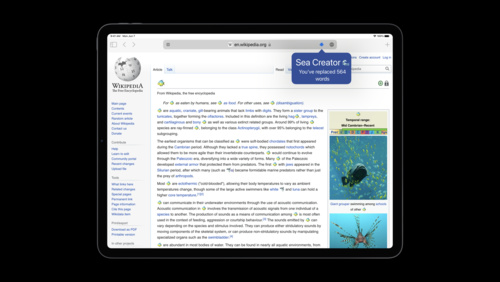 16:55
16:55
Explore Safari Web Extension improvements
Learn how you can extend Safari's functionality with Safari Web Extensions. We'll introduce you to the latest WebExtension APIs, explore non-persistent background page support — a particularly relevant topic if you're developing for iOS — and discover how you can use the Declarative Net Request...
App Services English, Japanese -
 16:14
16:14
Explore UWB-based car keys
Discover how to create digital car keys that support Ultra Wideband (UWB), allowing people to unlock and start their car while leaving iPhone in their bag or pocket or Apple Watch on their wrist. We'll show you how to integrate UWB, add proximity actions and distance unlock features, and help...
App Services English, Japanese, Simplified Chinese -
 26:51
26:51
Meet Shortcuts for macOS
Shortcuts is coming to macOS, and your apps are a key part of that process. Discover how you can elevate the capabilities of your app by exposing those features as Shortcuts actions. We'll show you how to build actions for your macOS apps built with Catalyst or AppKit, deploy actions across...
App Services English, Japanese, Simplified Chinese -
 20:59
20:59
Send communication and Time Sensitive notifications
Learn more about the evolution of notifications on Apple platforms. We'll explore how you can help people manage notifications within your app, including how you can craft meaningful moments with interruption levels and Time Sensitive notifications. And we'll introduce you to communication...
App Services English, Japanese, Simplified Chinese -
 17:49
17:49
Sync files to the cloud with FileProvider on macOS
Find out how you can use the FileProvider framework to build a comprehensive cloud sync solution. We'll show you how to approach building a file provider extension, and explore how you can effortlessly integrate your extension with file system features such as safe save, disk space management,...
App Services English, Japanese, Simplified Chinese -
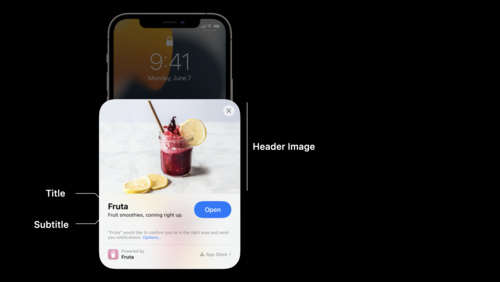 15:48
15:48
What's new in App Clips
Discover how App Clips can elevate quick and focused experiences for specific tasks, the moment your customer needs them. We'll take you through some of the latest improvements to App Clips, including launching an experience directly from an app, testing your App Clip locally, and creating App...
App Services English, Japanese, Simplified Chinese -
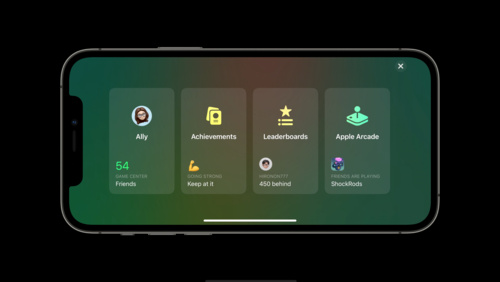 22:09
22:09
What’s new in Game Center: Widgets, friends, and multiplayer improvements
Power up your online gaming experience with GameKit and adopt features like multiplayer, leaderboards, and achievements in your game. We'll take you through the latest improvements to Game Center, including player matching and multiplayer APIs, and explore how you can boost discovery of your game.
App Services English, Japanese, Simplified Chinese
-
-
App Store Distribution & Marketing -
 15:30
15:30
Diagnose Power and Performance regressions in your app
Quickly discover how to identify priorities when viewing power and performance regressions. Learn how to track metrics that have regressed with device-and percentile-specific information, so you can focus your efforts on optimization and save valuable development time. We'll also show you how to...
App Store Distribution & Marketing English, Japanese, Simplified Chinese -
 21:06
21:06
Discover account-driven User Enrollment
Learn how User Enrollment helps you support “bring your own device” deployments in your business or enterprise environment. We'll explore data separation, enhancements to Managed Apple IDs and how you can use the new account-based onboarding in your organization.
App Store Distribution & Marketing English, Japanese, Simplified Chinese -
 21:50
21:50
Distribute apps in Xcode with cloud signing
Discover how to distribute your apps directly to App Store Connect and all the distribution methods supported in Xcode. Explore how to automate distribution for your apps, and learn about improvements to the distribution workflow like cloud signing, app record creation, and build number management.
App Store Distribution & Marketing English, Japanese, Simplified Chinese -
 15:31
15:31
Improve MDM assignment of Apps and Books
Discover the Apps and Books Management API and explore how you can assign an organization's owned apps and books to managed users and devices. Learn about the latest API improvements and find out how you can subscribe to and receive notifications around asset counts, assignments, and registered...
App Store Distribution & Marketing English, Japanese, Simplified Chinese -
 9:52
9:52
Manage devices with Apple Configurator
Apple Configurator is now more capable than ever. Whether you're provisioning iOS, iPadOS, and tvOS devices in your organization or servicing existing macOS devices, learn how Apple Configurator can help with key workflows. And, coming to iPhone in iOS 15, discover how you can bring Automated...
App Store Distribution & Marketing English, Japanese, Simplified Chinese -
 33:43
33:43
Manage in-app purchases on your server
Discover the latest updates to managing in-app purchases on your server. Explore how you can use servers to track status changes, handle refunds, and manage subscriber status. Learn about App Store server APIs around status and in-app purchase transactions, and find out how App Store server...
App Store Distribution & Marketing English, Japanese, Simplified Chinese -
 18:21
18:21
Manage software updates in your organization
In a managed device environment, you often need to control the pace of software updates while you test the latest operating systems within your company or education institution. Discover the tools you have at your disposal to defer, deploy, and enforce software updates.
App Store Distribution & Marketing English, Japanese, Simplified Chinese -
 37:30
37:30
Meet StoreKit 2
StoreKit 2 delivers powerful, Swift-native APIs for in-app purchases and auto-renewable subscriptions. Learn how you can easily implement in-app purchases and subscriptions, and discover APIs for retrieving product information, handling transactions, determining product entitlements and customer...
App Store Distribution & Marketing English, Japanese, Simplified Chinese -
 10:30
10:30
Meet TestFlight on Mac
TestFlight has come to Mac. Learn how you can manage builds and testers, collect feedback, and deploy your macOS app. Discover enhancements for internal testing and new features that integrate with Xcode Cloud to make testing even easier on all platforms.
App Store Distribution & Marketing English, Japanese, Simplified Chinese -
 22:18
22:18
Meet declarative device management
The future of device management is here: Learn how you can support mobile device management while allowing individual devices to be autonomous and proactive, bringing both increased performance and scalability. We'll show you how you can incorporate this declarative model in your MDM solution.
App Store Distribution & Marketing English, Japanese, Simplified Chinese -
 14:14
14:14
Meet in-app events on the App Store
Discover how you can promote timely events happening in your apps and games — like a game competition, a movie premiere, and more — directly on the App Store. We'll show you how in-app events now appear on the App Store and how to create, schedule, and manage them in App Store Connect.
App Store Distribution & Marketing English, Japanese, Simplified Chinese -
 19:09
19:09
Meet the Screen Time API
Explore the Screen Time API and learn how you can build apps that support customized parental controls — all while putting privacy first. Learn how you can use key features like core restrictions and device activity monitoring to create safe, secure experiences in your app while providing...
App Store Distribution & Marketing English, Japanese, Simplified Chinese -
 22:38
22:38
Qualities of great iPad and iPhone apps on Macs with M1
It's easier than ever to offer your existing iPad and iPhone apps on Macs with M1. We'll show you how to bring your app to macOS, and explore how the system automatically bridges various features of your app to work on the Mac. We'll also provide guidance on best practices in your iPad app,...
App Store Distribution & Marketing English, Japanese, Simplified Chinese -
 24:55
24:55
Support customers and handle refunds
Great customer support is critical to running a successful business on the App Store. Discover how you can provide a frictionless support experience to customers who make in-app purchases, including APIs that make it easy for customers to manage or cancel their auto-renewable subscription, or...
App Store Distribution & Marketing English, Japanese, Simplified Chinese -
 13:25
13:25
What's new in App Analytics
App Analytics helps you maximize your opportunity on the App Store by providing privacy-friendly insights about your app. Learn about four new ways to grow your business, including information about custom product pages, in-app events, product page optimization, and new metrics about transactions...
App Store Distribution & Marketing English, Japanese, Simplified Chinese -
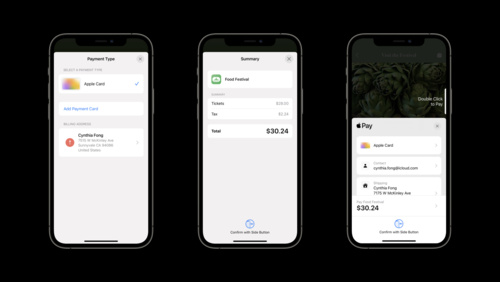 18:41
18:41
What's new in Wallet and Apple Pay
Discover the redesigned Apple Pay for in-app and web payments and learn how you can incorporate the latest APIs into your app or website. Learn how to add features to your app like coupon codes, improved shipping information, and improvements to the payment detail display screen. And explore...
App Store Distribution & Marketing English, Japanese, Simplified Chinese -
 14:26
14:26
What’s new in managing Apple devices
Discover the latest advancements in key device management capabilities for your organization or MDM solution. Explore the refreshed device management Settings on iOS and iPadOS, an all-new return to service functionality for macOS, and other updates to device management across Apple platforms.
App Store Distribution & Marketing English, Japanese, Simplified Chinese
-
-
Audio & Video -
 25:09
25:09
Build custom experiences with Group Activities
Go beyond basic streaming and interaction and discover how you can build advanced SharePlay experiences using the full power of the Group Activities framework. We'll show you how to adapt a simple drawing app into a real-time shared canvas, explore APIs like GroupSessionMessenger — which helps...
Audio & Video English, Japanese, Simplified Chinese -
 37:58
37:58
Coordinate media experiences with Group Activities
Discover how you can help people watch or listen to content all in sync with SharePlay and the Group Activities framework. We'll show you how to adapt a media app into a synchronized, SharePlay-enabled experience for multiple people. Learn how to add Group Activities to your app, explore the...
Audio & Video English, Japanese, Simplified Chinese -
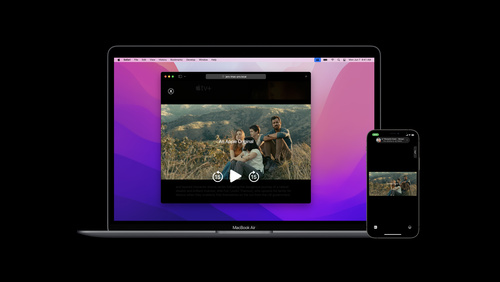 12:02
12:02
Coordinate media playback in Safari with Group Activities
Create SharePlay experiences that people can enjoy on the web and in your companion app. Learn how you can use the Group Activities framework in combination with a companion website to bring SharePlay to Safari, letting people connect with each other for enjoyable group interactions — even if...
Audio & Video English, Japanese, Simplified Chinese -
 18:38
18:38
Create audio drivers with DriverKit
Discover how to use the AudioDriverKit API to consolidate your Audio Server plug-in and DriverKit extension into a single package. Learn how you can simplify audio driver installation with an app instead of an installer package and distribute your driver through the Mac App Store. And we'll take...
Audio & Video English, Japanese, Simplified Chinese -
 15:53
15:53
Create custom audio experiences with ShazamKit
Bring custom audio matching to your app with ShazamKit. Discover how you can use Shazam's exact audio matching to recognize audio against any source when you use custom catalogs on device. Download our starter project and code along with the presenter as we guide you through the process of...
Audio & Video English, Japanese, Simplified Chinese -
 19:16
19:16
Discover built-in sound classification in SoundAnalysis
Explore how you can use the Sound Analysis framework in your app to detect and classify discrete sounds from any audio source — including live sounds from a microphone or from a video or audio file — and identify precisely in a moment where that sound occurs. Learn how the built-in sound...
Audio & Video English, Japanese, Simplified Chinese -
 37:28
37:28
Discover geometry-aware audio with the Physical Audio Spatialization Engine (PHASE)
Explore how geometry-aware audio can help you build complex, interactive, and immersive audio scenes for your apps and games. Meet PHASE, Apple's spatial audio API, and learn how the Physical Audio Spatialization Engine (PHASE) keeps the sound aligned with your experience at all times — helping...
Audio & Video English, Japanese, Simplified Chinese -
 8:40
8:40
Discover rolling clips with ReplayKit
Never again miss anyone's great moment in your game or app. Learn about ReplayKit's latest update — clips screen recording — which provides your app with a rolling buffer of past video and audio samples. When memorable moments happen, discover how you can record and save it for people, and find...
Audio & Video English, Japanese, Simplified Chinese -
 16:35
16:35
Evaluate videos with the Advanced Video Quality Tool
Learn how the Advanced Video Quality Tool (AVQT) can help you accurately assess the perceptual quality of your compressed video files. Utilizing the AVFoundation framework, AVQT supports a wide range of video formats, codecs, resolutions and frame-rates in both the SDR and HDR domains, which...
Audio & Video English, Japanese, Simplified Chinese -
 9:03
9:03
Explore Core Image kernel improvements
Discover how you can add Core Image kernels written in the Metal Shading Language into your app. We'll explore how you can use Xcode rules and naming conventions for Core Image kernels written in the Metal Shading Language, and help you make sense of Metal's Stitchable functions and dynamic...
Audio & Video English, Japanese, Simplified Chinese -
 34:16
34:16
Explore HDR rendering with EDR
EDR is Apple's High Dynamic Range representation and rendering pipeline. Explore how you can render HDR content using EDR in your app and unleash the dynamic range capabilities of your HDR display including Apple's internal displays and Pro Display XDR. We'll show you how game and pro app...
Audio & Video English, Japanese, Simplified Chinese -
 15:19
15:19
Explore dynamic pre-rolls and mid-rolls in HLS
Learn how you can create seamless transitions between advertisements and your HLS streams. We'll show you how to incorporate HLS tags and AVFoundation APIs to create media experiences that move easily between your primary content and mid-rolls, and provide best practices for playing these streams...
Audio & Video English, Japanese, Simplified Chinese -
 7:50
7:50
Explore the catalog with the Apple Music API
Discover how you can use the Apple Music API to fetch music catalog metadata for your app. Explore the latest updates to the API as well as some advanced techniques for shaping your requests and highlighting the right metadata for a project. To get the most out of this session, we recommend some...
Audio & Video English, Japanese, Simplified Chinese -
 18:17
18:17
Immerse your app in Spatial Audio
Discover how spatial audio can help you provide a theater-like experience for media in your apps and on the web. We'll show you how you can easily bring immersive audio to those listening with compatible hardware, and how to automatically deliver different listening experiences depending on...
Audio & Video English, Japanese, Simplified Chinese -
 13:02
13:02
Improve global streaming availability with HLS Content Steering
Discover how you can use HLS playlist tags and the Steering Manifest format with your content to help dynamically update CDN redundancy policies tuned for each viewer. Learn how to load balance, set failover, and more.
Audio & Video English, Japanese, Simplified Chinese -
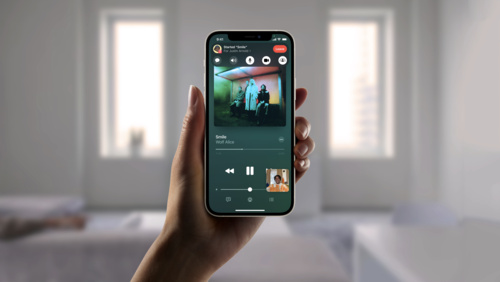 17:08
17:08
Meet Group Activities
Learn more about the framework powering SharePlay, and discover the different types of shared experiences you can implement for people who use your app. Explore a high-level overview of the framework's architecture and concepts, including how Group Activities and AVFoundation work in tandem, and...
Audio & Video English, Japanese, Simplified Chinese -
 17:46
17:46
Meet MusicKit for Swift
MusicKit makes it easy to integrate Apple Music into your app. Explore the Swift-based framework: We'll take you through the basic process of using MusicKit — including how to find, request, and play content — and show you how you can incorporate music subscription workflows into your app if...
Audio & Video English, Japanese, Simplified Chinese -
 10:33
10:33
Transition media gaplessly with HLS
Discover how you can create streaming media content that seamlessly transitions between episodes, songs, scenes, and individual resources. With gapless HLS playback, you can stitch together multiple pieces of content on the fly to create customized workouts, design interactive content, tell...
Audio & Video English, Japanese, Simplified Chinese -
 16:51
16:51
What’s new in AVFoundation
Discover the latest updates to AVFoundation, Apple's framework for inspecting, playing, and authoring audiovisual presentations. We'll explore how you can use AVFoundation to query attributes of audiovisual assets, further customize your custom video compositions with timed metadata, and author...
Audio & Video English, Japanese, Simplified Chinese
-
-
Business & Education -
 14:10
14:10
Meet ClassKit for file-based apps
The ClassKit framework can help surface educational activities within your app to teachers using the Schoolwork app. Discover how you can provide teachers with greater insights into student learning by adopting the latest file-based API to report student progress data within your app. We'll also...
Business & Education English, Japanese, Simplified Chinese
-
-
Design -
 10:12
10:12
Accessibility by design: An Apple Watch for everyone (ASL)
Discover how Apple creates products that work well for everyone. Learn from a few of the engineers and designers who helped build Apple Watch as they share stories that highlight our approach to accessible design, constant iteration, and community engagement. This version includes American Sign...
Design English -
 25:47
25:47
Create custom symbols
Discover how you can create custom iconography with the latest rendering modes in SF Symbols 3. We'll help you learn how to draw, edit, and annotate symbols, as well as explore more advanced techniques to improve the design process. For a primer on working with custom symbol templates, we...
Design English, Japanese, Simplified Chinese -
 33:32
33:32
Design for Safari 15
Meet Safari 15: redesigned and ready to help people explore the web. Discover how you can approach designing websites and apps for Safari, and learn how to incorporate the tab bar in your designs. We'll also take you through features like Live Text and accessibility best practices, explore the...
Design English, Japanese, Simplified Chinese -
 18:25
18:25
Design for spatial interaction
Discover the principles for creating intuitive physical interactions between two or more devices, as demonstrated by Apple designers who worked on features for iPhone, HomePod mini, and AirTag. Explore how you can apply these patterns to your own app when designing features for Apple platforms,...
Design English, Japanese, Simplified Chinese -
 32:44
32:44
Discoverable design
Discover how you can create interactive, memorable experiences to onboard people into your app. We'll take you through discoverable design practices and learn how you can craft explorable, fun interfaces that help people grasp the possibilities of your app at a glance. We'll also show you how to...
Design English, Japanese, Simplified Chinese -
 16:32
16:32
Out of this world... on to Mars
Fascinated by aerospace engineering and fighter jets from the age of 11, MIT graduate Tiera Fletcher followed her passion. At 22, she landed her dream job working on NASA's Space Launch System, the most powerful rocket created in history. Learn what it's like to design components of a...
Design English -
 16:00
16:00
Practice audio haptic design
Discover how you can deliver rich app experiences that include animation, sound, and haptics on iPhone. Learn key concepts for designing multimodal experiences within the Core Haptics framework. We'll take you through our sample HapticRicochet app — where haptic and sound feedback is designed in...
Design English, Japanese, Simplified Chinese -
 15:00
15:00
Tap into virtual and physical game controllers
It's time to up your input game: Learn about the latest improvements to virtual and physical game controllers for iPhone, iPad, Mac, and Apple TV. Meet the virtual on-screen controller, which turns touch input into game controller input, and find out how to add controller sharing features to your...
Design English, Simplified Chinese
-
-
Developer Tools -
 9:34
9:34
Automate CloudKit tests with cktool and declarative schema
It's never been easier to test your CloudKit containers. We'll introduce you to cktool, a command-line utility that makes quick work of CloudKit configuration, and learn about the new schema language that allows you to rapidly prototype and evolve containers. We'll also show you how to combine...
Developer Tools English, Japanese, Simplified Chinese -
 22:13
22:13
Build interactive tutorials using DocC
Discover how you can author immersive tutorials from scratch with DocC. We'll demonstrate how you can bring together rich instructions, example code, and images through the DocC syntax to showcase your Swift framework in action. And we'll go over how to create progressive training that can...
Developer Tools English, Japanese -
 19:15
19:15
Build interfaces with style
Discover how you can iterate upon your interfaces even more quickly when building your apps. Learn how you can modernize your UI with the latest button styles and table view cell content configurations, both of which give you greater control directly inside of Interface Builder. We'll show you...
Developer Tools English, Japanese, Simplified Chinese -
 21:48
21:48
Customize your advanced Xcode Cloud workflows
Xcode Cloud integrates with Apple Developer tools and services, all major source control management services, and even social collaboration tools like Slack. If your development process relies on additional tools and external services, however, you can fine-tune your workflows and the behavior of...
Developer Tools English, Japanese, Simplified Chinese -
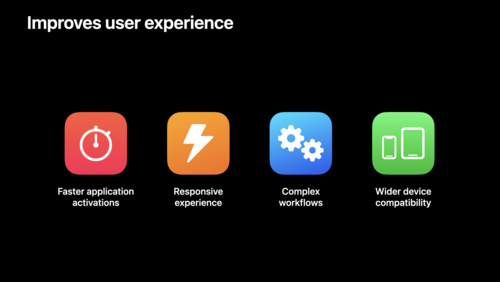 29:26
29:26
Detect and diagnose memory issues
Discover how you can understand and diagnose memory performance problems with Xcode. We'll take you through the latest updates to Xcode's tools, explore Metrics, check out the memgraph collection feature in XCTest, and learn how to catch regressions using a Performance XCTest.
Developer Tools English, Japanese, Simplified Chinese -
 9:13
9:13
Detect bugs early with the static analyzer
Discover how Xcode can automatically track down infinite loops, unused code, and other issues before you even run your app. Learn how, with a single click, Xcode can analyze your project to discover security issues, logical bugs, and other hard-to-spot errors in Objective-C, C, and C++. We'll...
Developer Tools English, Japanese, Simplified Chinese -
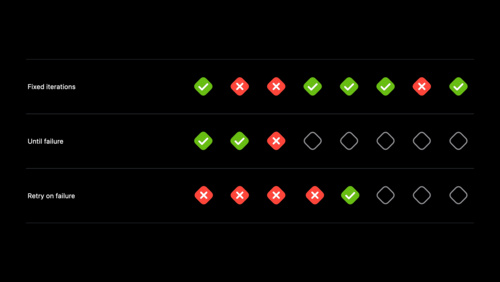 9:01
9:01
Diagnose unreliable code with test repetitions
Test repetitions can help you debug even the most unreliable code. Discover how you can use the maximum repetitions, until failure, and retry on failure testing modes within test plans, Xcode, and xcodebuild to track down bugs and crashers and make your app more stable for everyone. To get the...
Developer Tools English, Japanese -
 39:53
39:53
Discover Metal debugging, profiling, and asset creation tools
Explore how Xcode can help you take your Metal debugging, profiling and asset creation workflows to the next level. Discover the latest tools for ray tracing and GPU profiling, and learn about Metal Debugger workflows. We'll also show you how to use the Texture Converter tool, which supports all...
Developer Tools English, Japanese, Simplified Chinese -
 14:26
14:26
Discover and curate Swift Packages using Collections
Whether you're curating packages for your team, for education purposes, or to share with other developers, Swift Package Collections can help you discover, explore and import new packages into your project. Discover improvements in the Swift Package workflow using Collections, and learn how you...
Developer Tools English, Japanese, Simplified Chinese -
 12:34
12:34
Discover breakpoint improvements
Breakpoints can help you debug issues by allowing you to pause and inspect problems in the middle of a process. Discover the latest improvements to breakpoints in Xcode including column and unresolved breakpoints. We'll also go over best practices for general breakpoints and LLDB tips and tricks.
Developer Tools English, Japanese, Simplified Chinese -
 11:49
11:49
Embrace Expected Failures in XCTest
Testing is a crucial part of building a great app: Great tests can help you track down important issues before release, improve your workflow, and provide a quality experience upon release. For issues that can't be immediately resolved, however, XCTest can help provide better context around those...
Developer Tools English, Japanese -
 9:16
9:16
Explore Digital Crown, Trackpad, and iPad pointer automation
Learn how you can interact with devices in UI Tests in Xcode 13. Discover newly-automatable input methods including iPadOS pointer, watchOS Digital Crown, and enhanced macOS trackpad scrolling APIs.
Developer Tools English, Japanese, Simplified Chinese -
 23:49
23:49
Explore Xcode Cloud workflows
Learn how Xcode Cloud workflows can help you and your team automate building, analyzing, testing, archiving, and distributing your apps and frameworks. They are flexible, extensible, and can be configured around your team's development and distribution process. Find out the basics of Xcode Cloud...
Developer Tools English, Japanese, Simplified Chinese -
 25:37
25:37
Explore advanced project configuration in Xcode
Working with more complex Xcode projects? You've come to the right place. Discover how you can configure your project to build for multiple Apple platforms, filter content per-platform, create custom build rules and file dependencies, and more. We'll take you through multi-platform framework...
Developer Tools English, Japanese, Simplified Chinese -
 6:24
6:24
Faster and simpler notarization for Mac apps
Notarization works in tandem with macOS to help people safely download software for their Mac outside of the App Store. Discover how notarytool can help you quickly and easily notarize your Mac app for distribution. We'll show you how you can now notarize your apps with just a single command, and...
Developer Tools English, Japanese, Simplified Chinese -
 13:51
13:51
Host and automate your DocC documentation
Find out how you can easily host your Swift package and framework DocC documentation online. We'll take you through configuring your web server to host your generated DocC archives, and help you learn to use the xcodebuild tool to automate documentation generation and keep your web content...
Developer Tools English, Japanese, Simplified Chinese -
 22:51
22:51
Meet DocC documentation in Xcode
Discover how you can use DocC to build and share documentation for Swift packages and frameworks. We'll show you how to begin generating documentation from your own code — or from third-party code you depend upon — and write and format it using Markdown. And we'll also take you through the export...
Developer Tools English, Japanese, Simplified Chinese -
 32:27
32:27
Optimize high-end games for Apple GPUs
Optimize your high-end games for Apple GPUs: We'll show you how you can use our rendering and debugging tools to eliminate performance issues and make your games great on Apple platforms. Learn from our experiences working with developers at Larian Studios and 4A Games as we help them optimize...
Developer Tools English, Japanese, Simplified Chinese -
 11:16
11:16
Review code and collaborate in Xcode
Explore the latest enhancements to code review and pull requests in Xcode. Learn more about diff display preferences, commit selectors, changes navigator, and pull request workflows. We'll show you how you can collaborate with your team and find regressions by connecting your code review and PR...
Developer Tools English, Japanese, Simplified Chinese -
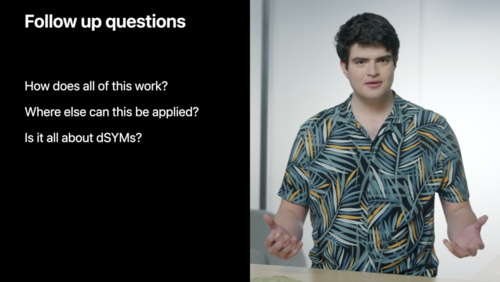 37:20
37:20
Symbolication: Beyond the basics
Discover how you can achieve maximum performance and insightful debugging with your app. Symbolication is at the center of tools such as Instruments and LLDB to help bridge the layers between your application's runtime and your source code. Learn how this process works and the steps you can take...
Developer Tools English, Japanese, Simplified Chinese -
 15:27
15:27
Triage TestFlight crashes in Xcode Organizer
Learn how Xcode Organizer makes it easier and faster to triage and fix crashes. We'll explore how you can get access to crash information and feedback from your TestFlight testers just moments after they occur. And we'll show you how to analyze crashes, view metrics, and even share crash...
Developer Tools English, Japanese, Simplified Chinese -
 24:00
24:00
Ultimate application performance survival guide
Performance optimization can seem like a daunting task — with many metrics to track and tools to use. Fear not: Our survival guide to app performance is here to help you understand tooling, metrics, and paradigms that can help smooth your development process and contribute to a great experience...
Developer Tools English, Japanese -
 24:24
24:24
Understand and eliminate hangs from your app
Discover how you can track down hangs and delays in your app. We'll show you tools and methods to discover hangs and their causes, learn about anti-patterns that can lead to hangs, explore best practices for eliminating hangs like GCD, and provide guidance on when you should consider asynchronous...
Developer Tools English, Japanese, Simplified Chinese
-
-
Essentials -
 14:26
14:26
AR Quick Look, meet Object Capture
Discover simple ways to bring your Object Capture assets to AR Quick Look while optimizing for visual quality and file size. Explore ways you can integrate AR Quick Look and Object Capture to help create entirely new experiences. To get the most out of this session, we recommend first watching...
Essentials English, Japanese, Simplified Chinese -
 33:50
33:50
Apple’s privacy pillars in focus
At Apple, we believe that privacy is a fundamental human right. Learn about our four pillars of privacy, how we brought these principles together to design iCloud Private Relay, and how you can approach building privacy in your app in line with those fundamentals. Explore how you can build data...
Essentials English, Japanese, Simplified Chinese -
 15:19
15:19
Build a research and care app, part 1: Setup onboarding
Learn how ResearchKit and CareKit can work together to take the tedium out of paper surveys. Code along with us and build a working care pilot app. Explore best practices for onboarding and consent with ResearchKit, and find out how your app can require participants to sign consent documents by...
Essentials English, Japanese, Simplified Chinese -
 15:55
15:55
Build a research and care app, part 2: Schedule tasks
Learn how ResearchKit and CareKit can work together to take the tedium out of paper surveys. Continue coding along with us and explore how you can make it easier than ever to schedule surveys for your study participants. You'll also learn advanced techniques for crafting evolving regiments in...
Essentials English, Japanese, Simplified Chinese -
 14:16
14:16
Build a research and care app, part 3: Visualize progress
Learn how ResearchKit and CareKit can work together to take the tedium out of paper surveys. Join us for the last part of our code along as we put the finishing touches on our care pilot app. Explore how you can use advanced CareKit APIs to customize the appearance and behavior of task cards,...
Essentials English, Japanese, Simplified Chinese -
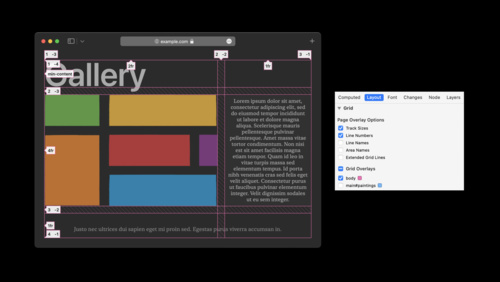 28:40
28:40
Discover Web Inspector improvements
Web Inspector provides the tools for you to understand and debug your web pages on macOS, iOS, and iPadOS. We'll take you through the latest features and improvements to Web Inspector, including a new overlay for inspecting CSS Grid containers on your pages, even more configurable breakpoints to...
Essentials English, Japanese, Simplified Chinese -
 17:46
17:46
Elevate your DocC documentation in Xcode
Great documentation can help people effectively and easily adopt your Swift framework. Discover how you can create rich, conceptual articles to accompany your API. You'll learn best practices for writing articles, including how to structure your documentation, and find out how to create...
Essentials English, Japanese, Simplified Chinese -
 12:47
12:47
Explore the SF Symbols 3 app
Tour the latest updates to the SF Symbols app — our interactive library for iconography. Learn how you can use the library to design accessible and inclusive apps that look incredible: We'll take you through changes to the app and symbols search, explore previewing and custom symbol management,...
Essentials English, Japanese, Simplified Chinese -
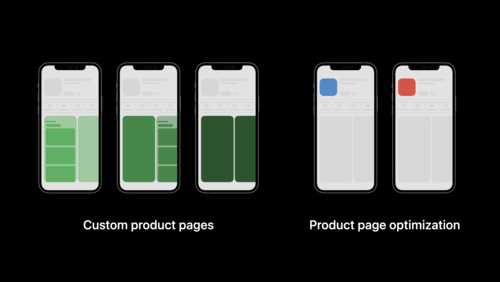 8:21
8:21
Get ready to optimize your App Store product page
Discover new ways to make your product page more relevant. Learn how you can use custom product pages to highlight different features and content in your app for different users. Explore how you can optimize your product page by comparing the effectiveness of different visual assets to see what...
Essentials English, Japanese, Simplified Chinese -
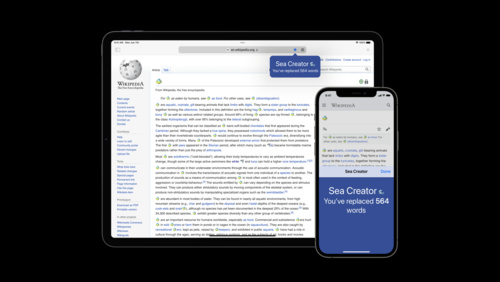 38:11
38:11
Meet Safari Web Extensions on iOS
Safari Web Extensions use HTML, CSS, and JavaScript to offer people powerful browser customizations — and you can now create them for every device that supports Safari. Learn how to build a Safari Web Extension that works for all devices, and discover how you can convert an existing extension to...
Essentials English, Japanese, Simplified Chinese -
 16:32
16:32
Meet Xcode Cloud
Get to know Xcode Cloud, Apple's continuous integration and continuous delivery (CI/CD) service for building apps and frameworks for all Apple platforms. Find out how Xcode Cloud can improve both the productivity of your team and the quality of your products. We'll show you how to start your...
Essentials English, Japanese, Simplified Chinese -
 13:22
13:22
Meet the Location Button
Meet CLLocationButton: a secure interface element that provides an easy, low-friction way to grant your app location access only when and where it is needed. Learn how you can add CLLocationButton to new or existing code, how to customize it within interface legibility guidelines, how to...
Essentials English, Japanese, Simplified Chinese -
 20:08
20:08
Meet the UIKit button system
Every app uses Buttons. With iOS 15, you can adopt updated styles to create gorgeous buttons that fit effortlessly into your interface. We'll explore features that make it easier to create different types of buttons, learn how to provide richer interactions, and discover how you can get great...
Essentials English, Simplified Chinese -
 26:52
26:52
Principles of great widgets
Explore the foundations of great widgets by keeping them relevant and customizable. Learn how to keep widgets up to date with timeline entries and TimelineReloadPolicies. Discover how to adapt your widget to different presentation environments and physical location. And lastly, find out how to...
Essentials English, Japanese, Simplified Chinese -
 24:20
24:20
Qualities of a great Mac Catalyst app
Discover best practices, tools, and techniques to help craft the best possible Mac Catalyst app. We'll take you through key considerations when you bring your iPad app to macOS, explore detailed code examples for refining your interface and experience, and show you how to distribute your Mac app...
Essentials English, Japanese, Simplified Chinese -
 17:29
17:29
SwiftUI on the Mac: Build the fundamentals
Code along with us as we use SwiftUI to build a Mac app from start to finish. Discover four principles all great Mac apps have in common, and learn how to apply those principles in practice using SwiftUI. We'll show you how to create a powerful, flexible sidebar experience and transform lists to...
Essentials English, Japanese, Simplified Chinese -
 17:28
17:28
SwiftUI on the Mac: The finishing touches
Join us for part two of our Code-Along series as we use SwiftUI to build a Mac app from start to finish. The journey continues as we explore how our sample gardening app can adapt to a person's preferences and specific workflows. Learn how SwiftUI apps can automatically react to system settings,...
Essentials English, Japanese, Simplified Chinese -
 36:16
36:16
Take your iPad apps to the next level
Make even better iPad apps: Learn how you can adopt prominent scenes for uninterrupted, focused interactions. Help people stay engaged and fast with keyboard shortcuts and the keyboard shortcut interface. Explore how the latest in pointer enhancements can help your app boost productivity.
Essentials English, Japanese, Simplified Chinese -
 8:05
8:05
What's new in AVKit
Learn about enhancements to Picture in Picture and full screen improvements on macOS. Explore the new content source API, and learn how AVPictureInPictureController supports AVSampleBufferDisplayLayer, as well as recommended steps for an app to provide a seamless full screen experience on macOS...
Essentials English, Japanese, Simplified Chinese -
 21:32
21:32
What's new in AppKit
Explore the latest advancements in Mac app development with AppKit. We'll show how you can enhance your app's design with new control features and SF Symbols 3, build powerful text experiences using TextKit 2, and harness the latest Swift features in your app.
Essentials English, Japanese, Simplified Chinese -
 26:49
26:49
What's new in CloudKit
CloudKit provides a secure, convenient, and reliable cloud database for your apps — and it's only getting better. Discover how you can unravel your threads with support for async/await and convenience API additions. We'll also show you how to encourage collaboration between people using your app...
Essentials English, Japanese, Simplified Chinese -
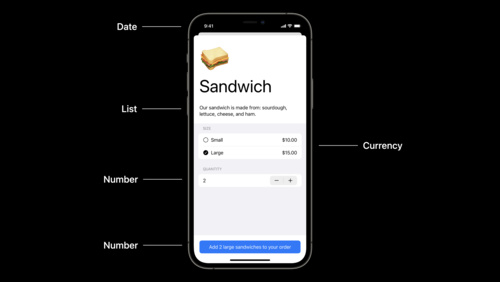 37:35
37:35
What's new in Foundation
Discover how the latest updates to Foundation can help you improve your app's localization and internationalization support. Find out about the new AttributedString, designed specifically for Swift, and learn how you can use Markdown to apply style to your localized strings. Explore the grammar...
Essentials English, Japanese, Simplified Chinese -
 26:33
26:33
What's new in Mac Catalyst
Discover the latest updates to Mac Catalyst and find out how you can make your app feel even more at home on macOS. Learn about a variety of new and enhanced UIKit APIs that let you customize your Mac Catalyst app to take advantage of behaviors unique to macOS. To get the most out of this...
Essentials English, Japanese, Simplified Chinese -
 40:13
40:13
What's new in SwiftUI
There's never been a better time to develop your apps with SwiftUI. Discover the latest updates to the UI framework — including lists, buttons, and text fields — and learn how these features can help you more fully adopt SwiftUI in your app. Find out how to create beautiful, visually-rich...
Essentials English, Japanese, Simplified Chinese -
 26:52
26:52
What's new in UIKit
Discover the latest updates and improvements to UIKit and learn how to build better iPadOS, iOS, and Mac Catalyst apps. We'll take you through UI refinements, productivity updates, and API enhancements, and help you explore performance improvements and security & privacy features.
Essentials English, Japanese, Simplified Chinese -
 19:46
19:46
What's new in watchOS 8
watchOS 8 brings all-new opportunities to keep people up to date on their watch face. With new APIs for the Always-On Retina display and updating complications from Bluetooth devices and background delivery of HealthKit data, it's never been easier to keep your app up to date. Learn about...
Essentials English, Japanese, Simplified Chinese -
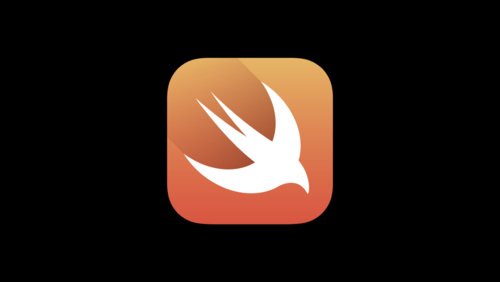 32:45
32:45
What‘s new in Swift
Join us for an update on Swift. Discover the latest language advancements that make your code easier to read and write. Explore the growing number of APIs available as Swift packages. And we'll introduce you to Swift's async/await syntax, structured concurrency, and actors.
Essentials English, Japanese, Simplified Chinese -
 20:31
20:31
What’s new in SF Symbols
Explore the latest updates to SF Symbols, Apple's iconography library. Designed to integrate seamlessly with San Francisco — the system font for Apple platforms — SF Symbols can help you create beautiful and consistent iconography for your app while supporting accessibility features like Dynamic...
Essentials English, Japanese, Simplified Chinese
-
-
Graphics & Games -
 23:56
23:56
Add rich graphics to your SwiftUI app
Learn how you can bring your graphics to life with SwiftUI. We'll begin by working with safe areas, including the keyboard safe area, and learn how to design beautiful, edge-to-edge graphics that won't underlap the on-screen keyboard. We'll also explore the materials and vibrancy you can use in...
Graphics & Games English, Japanese, Simplified Chinese -
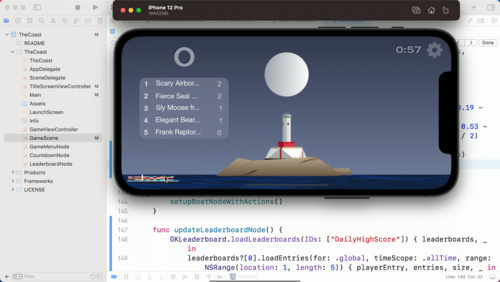 25:55
25:55
Bring Recurring Leaderboards to your game
Recurring leaderboards are a great way to encourage players to keep coming back to your game. Code along with us as we take you through how to set up a recurring leaderboard, both within App Store Connect and in your game itself. For a refresher on the differences between recurring and classic...
Graphics & Games English, Japanese, Simplified Chinese -
 26:31
26:31
Capture and process ProRAW images
When you support ProRAW in your app, you can help photographers easily capture and edit images by combining standard RAW information with Apple's advanced computational photography techniques. We'll take you through an overview of the format, including the look and feel of ProRAW images, quality...
Graphics & Games English, Japanese, Simplified Chinese -
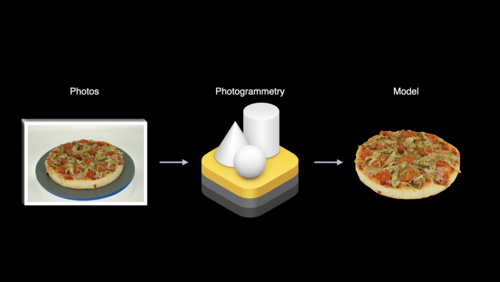 27:56
27:56
Create 3D models with Object Capture
Object Capture provides a quick and easy way to create lifelike 3D models of real-world objects using just a few images. Learn how you can get started and bring your assets to life with Photogrammetry for macOS. And discover best practices with object selection and image capture to help you...
Graphics & Games English, Japanese, Simplified Chinese -
 14:51
14:51
Create 3D workflows with USD
Discover the flexibility, versatility and power of Pixar's Universal Scene Description (USD) for your 3D workflows. Learn how you can use the USD file format in your professional workflows for macOS: Scan 3D models of your real-world objects using Object Capture, utilize the potential of...
Graphics & Games English, Japanese -
 29:34
29:34
Create image processing apps powered by Apple silicon
Discover how to optimize your image processing app for Apple silicon. Explore how to take advantage of Metal render command encoders, tile shading, unified memory architecture, and memoryless attachments. We'll show you how to use Apple's unique tile based deferred renderer architecture to create...
Graphics & Games English, Japanese, Simplified Chinese -
 24:52
24:52
Discover compilation workflows in Metal
The Metal shading language is a powerful C++ based language that allows apps to render stunning effects while maintaining a flexible shader development pipeline. Discover how to more easily build and extend your render pipelines using Dynamic Libraries and Function Pointers. We'll also show you...
Graphics & Games English, Japanese, Simplified Chinese -
 25:07
25:07
Dive into RealityKit 2
Creating engaging AR experiences has never been easier with RealityKit 2. Explore the latest enhancements to the RealityKit framework and take a deep dive into this underwater sample project. We'll take you through the improved Entity Component System, streamlined animation pipeline, and the...
Graphics & Games English, Japanese, Simplified Chinese -
 29:50
29:50
Enhance your app with Metal ray tracing
Achieve photorealistic 3D scenes in your apps and games through ray tracing, a core part of the Metal graphics framework and Shading Language. We'll explore the latest improvements in implementing ray tracing and take you through upgrades to the production rendering process. Discover Metal APIs...
Graphics & Games English, Japanese, Simplified Chinese -
 20:28
20:28
Explore ARKit 5
Build the next generation of augmented reality apps with ARKit 5. Explore how you can use Location Anchors in additional regions and more easily onboard people into your location-based AR experience. Learn more about Face Tracking and Motion Capture. And discover best practices for placing your...
Graphics & Games English, Japanese, Simplified Chinese -
 29:53
29:53
Explore advanced rendering with RealityKit 2
Create stunning visuals for your augmented reality experiences with cutting-edge rendering advancements in RealityKit. Learn the art of writing custom shaders, draw real-time dynamic meshes, and explore creative post-processing effects to help you stylize your AR scene.
Graphics & Games English, Japanese, Simplified Chinese -
 21:12
21:12
Explore bindless rendering in Metal
Unleash the full potential of your shaders and implement modern rendering techniques by adding Argument Buffers to adopt bindless rendering. Learn how to make your entire scene and resources available to the GPU to make the most out of raytracing and rasterization pipelines.
Graphics & Games English, Japanese, Simplified Chinese -
 29:48
29:48
Explore hybrid rendering with Metal ray tracing
Discover how you can combine ray tracing with your rasterization engine to implement simplified graphics techniques and elevate visuals in your app or game. We'll explore how you can use natural algorithms to accurately simulate the interplays of light, and learn how to take advantage of the...
Graphics & Games English, Japanese, Simplified Chinese -
 23:20
23:20
Optimize for variable refresh rate displays
Discover how to achieve smooth screen updates on all Apple platforms that support dynamic display timing. Learn techniques for pacing full-screen game updates on Adaptive Sync displays in macOS, and find out how Low Power Mode and other system states affect frame rate availability on ProMotion...
Graphics & Games English, Japanese, Simplified Chinese
-
-
Health & Fitness -
 54:09
54:09
Build a workout app for Apple Watch
Build a workout app from scratch using SwiftUI and HealthKit during this code along. Learn how to support the Always On state using timelines to update workout metrics. Follow best design practices for workout apps.
Health & Fitness English, Japanese, Simplified Chinese -
 10:31
10:31
Connect Bluetooth devices to Apple Watch
Discover how you can integrate data from Bluetooth accessories into Apple Watch apps and complications. Bluetooth devices can provide medical data, sports stats, and more to Apple Watch, and help people get more out of your software in the process. We'll show you how to connect to these devices...
Health & Fitness English, Simplified Chinese -
 20:49
20:49
Measure health with motion
Discover how you can take your app's health monitoring to the next level with motion data. Meet Walking Steadiness for iPhone and the six-minute-walk metric for Apple Watch: Walking Steadiness can help your app interpret someone's quality of walking and risk of falling, while the six-minute-walk...
Health & Fitness English, Japanese, Simplified Chinese -
 29:26
29:26
Meditation for fidgety skeptics
Dan Harris is an Emmy Award-winning journalist and the co-anchor of ABC's weekend editions of Good Morning America. After having a nationally-televised panic attack in 2004, he found himself on a long and often bizarre journey that ended with him discovering mindfulness meditation. Dan will share...
Health & Fitness English
-
-
ML & Vision -
 29:12
29:12
Accelerate machine learning with Metal Performance Shaders Graph
Metal Performance Shaders Graph is a compute engine that helps you build, compile, and execute customized multidimensional graphs for linear algebra, machine learning, computer vision, and image processing. Discover how MPSGraph can accelerate the popular TensorFlow platform through a Metal...
ML & Vision English, Japanese, Simplified Chinese -
 16:49
16:49
Build dynamic iOS apps with the Create ML framework
Discover how your app can train Core ML models fully on device with the Create ML framework, enabling adaptive and customized app experiences, all while preserving data privacy. We'll explore the types of models that can be created on-the-fly for image-based tasks like Style Transfer and Image...
ML & Vision English, Japanese, Simplified Chinese -
 17:58
17:58
Detect people, faces, and poses using Vision
Discover the latest updates to the Vision framework to help your apps detect people, faces, and poses. Meet the Person Segmentation API, which helps your app separate people in images from their surroundings, and explore the latest contiguous metrics for tracking pitch, yaw, and the roll of the...
ML & Vision English, Japanese, Simplified Chinese -
 19:12
19:12
Extract document data using Vision
Discover how Vision can provide expert image recognition and analysis in your app to extract information from documents, recognize text in multiple languages, and identify barcodes. We'll explore the latest updates to Text Recognition and Barcode Detection, show you how to bring all these tools...
ML & Vision English, Japanese, Simplified Chinese -
 24:30
24:30
Tune your Core ML models
Bring the power of machine learning directly to your apps with Core ML. Discover how you can take advantage of the CPU, GPU, and Neural Engine to provide maximum performance while remaining on device and protecting privacy. Explore MLShapedArray, which makes it easy to work with multi-dimensional...
ML & Vision English, Japanese, Simplified Chinese -
 14:22
14:22
Use Accelerate to improve performance and incorporate encrypted archives
The Accelerate framework helps you make large-scale mathematical computations and image calculations that are optimized for high-performance, low-energy consumption. Explore the latest updates to Accelerate and its Basic Neural Network Subroutines library, including additional layers, activation...
ML & Vision English, Simplified Chinese
-
-
Maps & Location -
 23:01
23:01
Explore Nearby Interaction with third-party accessories
Discover how your app can interact with Ultra Wideband (UWB) third-party accessories when running on a U1-equipped device. We'll show you how to use the Nearby Interaction framework's standards-based technology to implement precise and directionally-aware experiences with accessories. Learn about...
Maps & Location English, Japanese, Simplified Chinese
-
-
Photos & Camera -
 14:39
14:39
Capture high-quality photos using video formats
Your app can take full advantage of the powerful camera systems on iPhone by using the AVCapture APIs. Learn how to choose the most appropriate photo or video formats for your use cases while balancing the trade-offs between photo quality and delivery speed. Discover some powerful new algorithms...
Photos & Camera English, Japanese, Simplified Chinese -
 19:57
19:57
Explore low-latency video encoding with VideoToolbox
Supporting low latency encoders has become an important aspect of video application development process. Discover how VideoToolbox supports low-delay H.264 hardware encoding to minimize end-to-end latency and achieve new levels of performance for optimal real-time communication and high-quality...
Photos & Camera English, Japanese, Simplified Chinese -
 17:58
17:58
Improve access to Photos in your app
PHPicker is the simplest and most secure way to integrate the Photos library into your app — and it's getting even better. Learn how to handle ordered selection of images in your app, as well as pre-selecting assets any time the picker is shown. And for apps that need to integrate more deeply...
Photos & Camera English, Japanese -
 11:34
11:34
Use the camera for keyboard input in your app
Learn how you can support Live Text and intelligently pull information from the camera to fill out forms and text fields in your app. We'll show you how to apply content filtering to capture the correct information when someone uses the camera as keyboard input and apply it to a relevant...
Photos & Camera English, Japanese, Simplified Chinese -
 36:02
36:02
What’s new in camera capture
Learn how you can interact with Video Effects in Control Center including Center Stage, Portrait mode, and Mic modes. We'll show you how to detect when these features have been enabled for your app and explore ways to adopt custom interfaces to make them controllable from within your app...
Photos & Camera English, Simplified Chinese
-
-
Privacy & Security -
 33:57
33:57
Analyze HTTP traffic in Instruments
Learn to use the Instruments Network template to record and analyze your app's HTTP traffic. We'll show you how to explore and visualize the behavior of sessions, tasks, and individual HTTP requests to ensure data is transmitted efficiently and respects people's privacy.
Privacy & Security English, Japanese, Simplified Chinese -
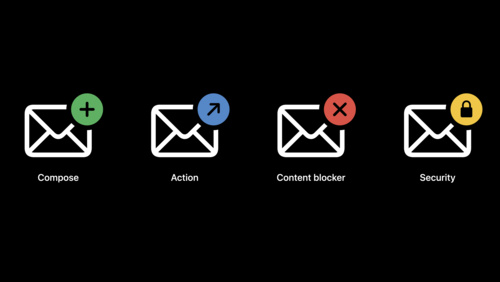 18:21
18:21
Build Mail app extensions
Meet MailKit: the best way to build amazing experiences on top of Mail. MailKit enables apps to easily and securely interact with the Mail app for macOS. We'll deep dive into the MailKit API, and show you how to create extensions for composing messages, message actions, secure email, and content...
Privacy & Security English, Japanese, Simplified Chinese -
 18:24
18:24
Explore Verifiable Health Records
Find out how you can securely request access to someone's verifiable health records and incorporate that data safely into your app. The Health app helps people download, view, and share their health records, including their COVID-19 immunization and test results — and iOS 15 brings support for...
Privacy & Security English, Japanese, Simplified Chinese -
 19:15
19:15
Mitigate fraud with App Attest and DeviceCheck
Discover how to use App Attest and DeviceCheck, Apple's powerful anti-fraud tools, created to safeguard your apps and content. Unlock the secrets of deploying App Attest by incorporating it into your app to block unauthorized modifications of your app and content. We'll also show you how to use...
Privacy & Security English, Japanese, Simplified Chinese -
 11:56
11:56
Safeguard your accounts, promotions, and content
Discover how to keep your accounts, apps, and content protected. We'll explore the tools Apple has built to help developers keep their apps and systems safe and secure, and show you how to safeguard against attackers, bad actors and nefarious activity to help protect your ecosystem.
Privacy & Security English, Japanese -
 7:56
7:56
Simplify sign in for your tvOS apps
Find out how people can use Face ID or Touch ID on their iOS or iPadOS device to authorize purchases and sign into your tvOS app. Discover how you can simplify sign in for people using your app and help them get to the content they want to enjoy, faster. We'll show you how to set up a simplified...
Privacy & Security English, Japanese, Simplified Chinese
-
-
Safari & Web -
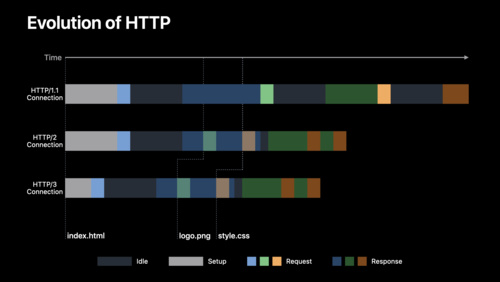 19:51
19:51
Accelerate networking with HTTP/3 and QUIC
The web is changing, and the next major version of HTTP is here. Learn how HTTP/3 reduces latency and improves reliability for your app and discover how its underlying transport, QUIC, unlocks new innovations in your own custom protocols using new transport functionality and multi-streaming...
Safari & Web English, Japanese, Simplified Chinese -
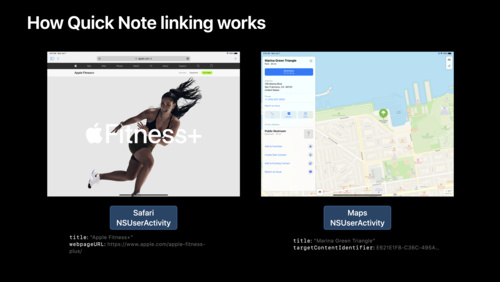 14:46
14:46
Adopt Quick Note
Learn how you can link your app to Quick Note and help people quickly connect your content to their notes — and their notes to your content. Discover how Quick Note recognizes and links to app content through NSUserActivity, and find out how you can adopt this API in your app. We'll take you...
Safari & Web English, Japanese, Simplified Chinese -
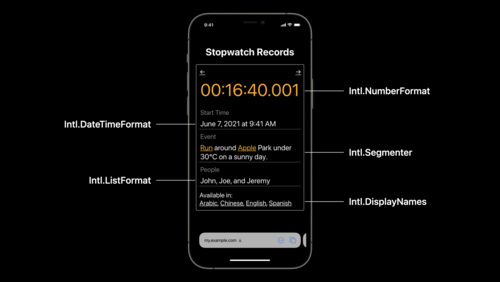 36:32
36:32
Develop advanced web content
Develop in JavaScript, WebGL, or WebAssembly? Learn how the latest updates to Safari and WebKit — including language changes to class syntax — can help simplify your development process, enhance performance, and improve security. We'll explore several web APIs that can help provide better...
Safari & Web English, Japanese, Simplified Chinese -
 21:44
21:44
Explore WKWebView additions
Explore the latest updates to WKWebView. We'll show you how to use APIs to manipulate web content without JavaScript, explore delegates that can help with WebRTC and Downloads, and share how you can easily create a richer web experience within your app.
Safari & Web English, Japanese -
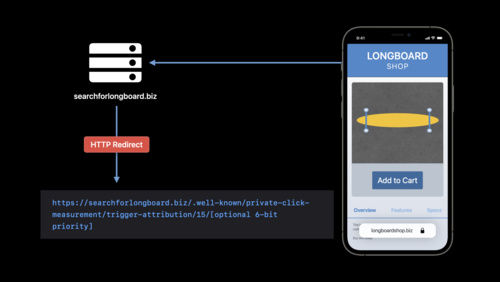 22:31
22:31
Meet privacy-preserving ad attribution
Discover how you can measure your ad campaigns in apps and on the web without compromising privacy. We'll introduce you to Private Click Measurement and explore SKAdNetwork, which provides you with a more secure, private, and useful way to measure your app installs.
Safari & Web English, Japanese, Simplified Chinese -
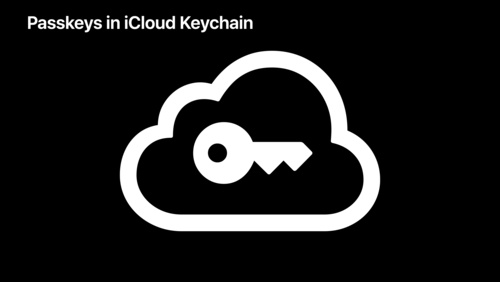 25:21
25:21
Move beyond passwords
Despite their prevalence, passwords inherently come with challenges that make them poorly suited to securing someone's online accounts. Learn more about the challenges passwords pose to modern security and how to move beyond them. Explore the next frontier in account security with...
Safari & Web English, Japanese, Simplified Chinese -
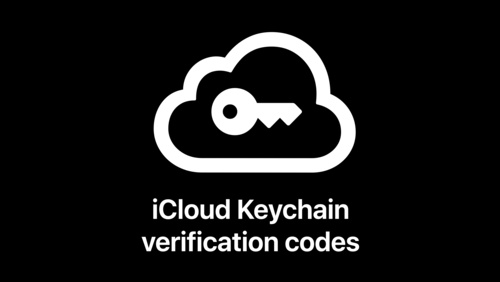 14:32
14:32
Secure login with iCloud Keychain verification codes
Learn how you can support on-device verification codes in your app or website for a more secure sign-in experience. We'll explore the latest updates to the iCloud Keychain password manager and discover how verification codes, AutoFill, iCloud Keychain sync, and two-tap setup simplify the...
Safari & Web English, Japanese, Simplified Chinese
-
-
Spatial Computing -
 26:49
26:49
Classify hand poses and actions with Create ML
With Create ML, your app's ability to understand the expressiveness of the human hand has never been easier. Discover how you can build off the support for Hand Pose Detection in Vision and train custom Hand Pose and Hand Action classifiers using the Create ML app and framework. Learn how simple...
Spatial Computing English, Japanese, Simplified Chinese -
 15:07
15:07
Explore ShazamKit
Take advantage of Shazam's exact audio matching capabilities within your app when you use ShazamKit. Learn how you can harness the immense Shazam catalog to create all sorts of experiences, including quickly recognizing the exact song playing in the background of a video captured by your app,...
Spatial Computing English, Japanese, Simplified Chinese
-
-
Swift -
 20:42
20:42
ARC in Swift: Basics and beyond
Learn about the basics of object lifetimes and ARC in Swift. Dive deep into what language features make object lifetimes observable, consequences of relying on observed object lifetimes and some safe techniques to fix them.
Swift English, Japanese, Simplified Chinese -
 27:04
27:04
Bring Core Data concurrency to Swift and SwiftUI
Discover how Core Data is adopting the new concurrency capabilities of Swift 5.5, leading to more concise, efficient, and safe asynchronous code. We'll show you how to update Core Data in your apps to work with concurrency, and detail the many other improvements throughout the framework that make...
Swift English, Japanese, Simplified Chinese -
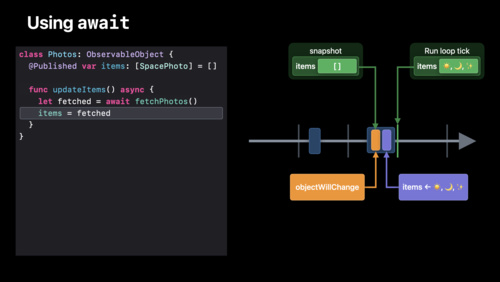 22:54
22:54
Discover concurrency in SwiftUI
Discover how you can use Swift's concurrency features to build even better SwiftUI apps. We'll show you how concurrent workflows interact with your ObservableObjects, and explore how you can use them directly in your SwiftUI views and models. Find out how to use await to make your app run...
Swift English, Japanese, Simplified Chinese -
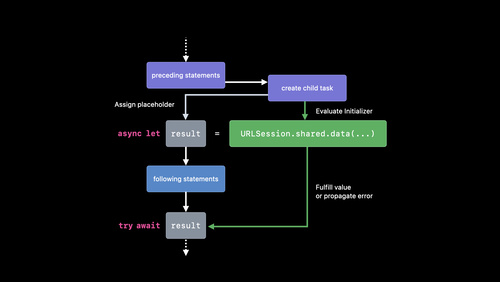 27:54
27:54
Explore structured concurrency in Swift
When you have code that needs to run at the same time as other code, it's important to choose the right tool for the job. We'll take you through the different kinds of concurrent tasks you can create in Swift, show you how to create groups of tasks, and find out how to cancel tasks in progress...
Swift English, Japanese, Simplified Chinese -
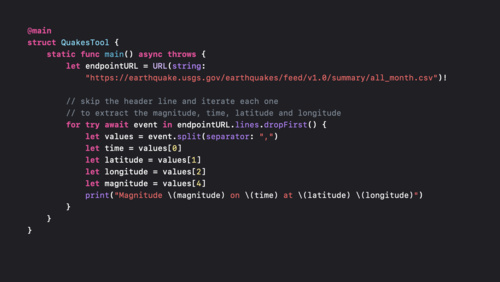 14:21
14:21
Meet AsyncSequence
Iterating over a sequence of values over time is now as easy as writing a “for” loop. Find out how the new AsyncSequence protocol enables a natural, simple syntax for iterating over anything from notifications to bytes being streamed from a server. We'll also show you how to adapt existing code...
Swift English, Japanese, Simplified Chinese -
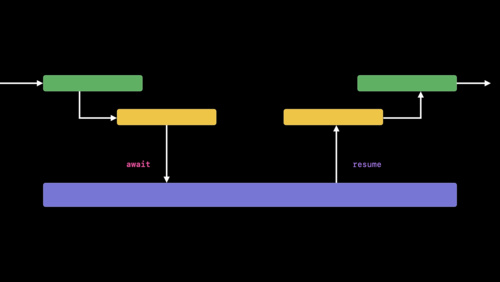 33:39
33:39
Meet async/await in Swift
Swift now supports asynchronous functions — a pattern commonly known as async/await. Discover how the new syntax can make your code easier to read and understand. Learn what happens when a function suspends, and find out how to adapt existing completion handlers to asynchronous functions.
Swift English, Japanese -
 30:30
30:30
Meet the Swift Algorithms and Collections packages
Discover two of the latest additions to the list of open-source Swift packages from Apple: Swift Algorithms and Swift Collections. Not only can you use these packages immediately, they also incubate new algorithms and data structures for eventual inclusion in the Swift Standard Library. We'll...
Swift English, Japanese, Simplified Chinese -
 28:32
28:32
Protect mutable state with Swift actors
Data races occur when two separate threads concurrently access the same mutable state. They are trivial to construct, but are notoriously hard to debug. Discover how you can stop these data races in their tracks with Swift actors, which help synchronize access to data in your code. Discover how...
Swift English, Japanese, Simplified Chinese -
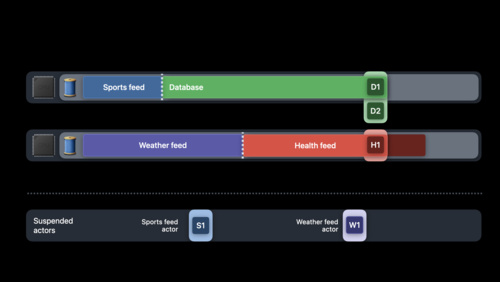 39:18
39:18
Swift concurrency: Behind the scenes
Dive into the details of Swift concurrency and discover how Swift provides greater safety from data races and thread explosion while simultaneously improving performance. We'll explore how Swift tasks differ from Grand Central Dispatch, how the new cooperative threading model works, and how to...
Swift English, Japanese, Simplified Chinese -
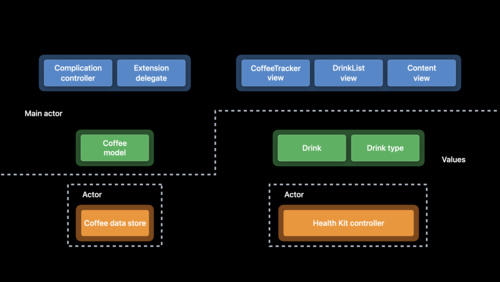 61:00
61:00
Swift concurrency: Update a sample app
Discover Swift concurrency in action: Follow along as we update an existing sample app. Get real-world experience with async/await, actors, and continuations. We'll also explore techniques for migrating existing code to Swift concurrency over time. To get the most out of this code-along, we...
Swift English, Japanese -
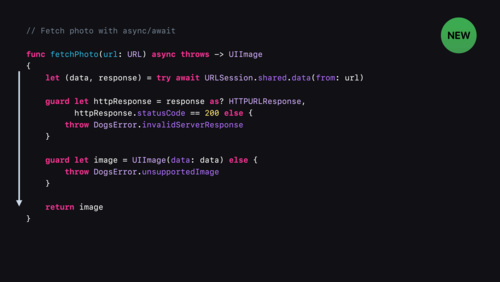 13:40
13:40
Use async/await with URLSession
Discover how you can adopt Swift concurrency in URLSession using async/await and AsyncSequence, and how you can apply Swift concurrency concepts to improve your networking code.
Swift English, Japanese, Simplified Chinese -
 46:56
46:56
Write a DSL in Swift using result builders
Some problems are easier to solve by creating a customized programming language, or “domain-specific language.” While creating a DSL traditionally requires writing your own compiler, you can instead use result builders with Swift 5.4 to make your code both easier to read and maintain. We'll take...
Swift English, Japanese, Simplified Chinese
-
-
SwiftUI & UI Frameworks -
 19:24
19:24
Add intelligence to your widgets
Discover how to you can add intelligence to your widgets in Smart Stacks. We'll show you how to use the new Widget Suggestions API in tandem with Smart Rotate to create more valuable widget experiences for people throughout the day. Whether you inform the system of new, timely information or...
SwiftUI & UI Frameworks English, Japanese, Simplified Chinese -
 24:35
24:35
Build apps that share data through CloudKit and Core Data
Learn how to easily build apps that share data between multiple iCloud users with NSPersistentCloudKitContainer. Discover how to create informative experiences around shared data and learn about the CloudKit technologies that support these features in Core Data. To get the most out of this...
SwiftUI & UI Frameworks English, Japanese, Simplified Chinese -
 11:42
11:42
Craft search experiences in SwiftUI
Discover how you can help people quickly find specific content within your apps. Learn how to use SwiftUI's .searchable modifier in conjunction with other views to best incorporate search for your app. And we'll show you how to elevate your implementation by providing search suggestions to help...
SwiftUI & UI Frameworks English, Japanese, Simplified Chinese -
 12:12
12:12
Customize and resize sheets in UIKit
Discover how you can create a layered and customized sheet experience in UIKit. We'll explore how you can build a non-modal experience in your app to allow interaction with content both in a sheet and behind the sheet at the same time. We'll also take you through sheet size customization,...
SwiftUI & UI Frameworks English, Japanese, Simplified Chinese -
 10:35
10:35
Deliver a great playback experience on tvOS
Find out how you can use Apple TV's redesigned playback interface to build great media experiences in your apps. Learn how the latest interface helps people access relevant controls and information while maintaining focus on content. We'll show you how you can adopt AVPlayerViewController and...
SwiftUI & UI Frameworks English, Japanese, Simplified Chinese -
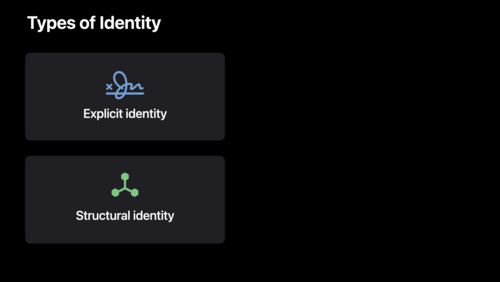 40:17
40:17
Demystify SwiftUI
Peek behind the curtain into the core tenets of SwiftUI philosophy: Identity, Lifetime, and Dependencies. Find out about common patterns, learn the principles that drive the framework, and discover how you can use them to guarantee correctness and performance for your app.
SwiftUI & UI Frameworks English, Japanese, Simplified Chinese -
 11:10
11:10
Direct and reflect focus in SwiftUI
With device input — as with all things in life — where you put focus matters. Discover how you can move focus in your app with SwiftUI, programmatically dismiss the keyboard, and build large navigation targets from small views. Together, these APIs can help you simplify your app's interface and...
SwiftUI & UI Frameworks English, Japanese, Simplified Chinese -
 20:23
20:23
Focus on iPad keyboard navigation
Improve the keyboard experience in your iPad and Mac Catalyst app. Discover how you can accelerate access to key features with the hardware keyboard, and navigate through your views and view controllers. Learn how to customize which elements are keyboard navigable, as well as how to customize the...
SwiftUI & UI Frameworks English, Japanese -
 22:30
22:30
Make blazing fast lists and collection views
Build consistently smooth scrolling list and collection views: Explore the lifecycle of a cell and learn how to apply that knowledge to eliminate rough scrolling and missed frames. We'll also show you how to improve your overall scrolling experience and avoid costly hitches, with optimized image...
SwiftUI & UI Frameworks English, Japanese, Simplified Chinese -
 41:04
41:04
Meet TextKit 2
Meet TextKit 2: Apple's next-generation text engine, redesigned for improved correctness, safety, and performance. Discover how TextKit 2 can help you provide a better text experience for international audiences, create more diverse layouts by mixing text content with visual content, and ensure...
SwiftUI & UI Frameworks English, Japanese, Simplified Chinese -
 10:57
10:57
SF Symbols in SwiftUI
Discover how you can incorporate SF Symbols into your SwiftUI app. We'll explore basic techniques for presenting symbols, customizing their size, and showing different variants. We'll also take you through the latest updates to symbol colorization and help you pick the right tool for your app's...
SwiftUI & UI Frameworks English, Japanese, Simplified Chinese -
 15:06
15:06
SF Symbols in UIKit and AppKit
Learn how you can create colorized symbols with SF Symbols 3 and customize them to match the visual design of your app's interface. We'll take you through the latest UIKit and AppKit APIs for integrating colorized symbols, as well as best practices for implementation. To get the most out of this...
SwiftUI & UI Frameworks English, Japanese, Simplified Chinese -
 16:33
16:33
Showcase app data in Spotlight
Discover how Core Data can surface data from your app in Spotlight with as little as two lines of code. Learn how to make that data discoverable in Spotlight search and to customize how it is presented to people on device. Lastly, we'll show you how to implement full-text search within your app,...
SwiftUI & UI Frameworks English, Japanese, Simplified Chinese
-
-
System Services -
 17:42
17:42
Add support for Matter in your smart home app
The enhanced and new APIs in HomeKit enable smart home developers to integrate with the new Matter protocol in the most convenient way. Tour the Matter protocol, and discover how to set up and manage Matter accessories on our platforms and within your smart home apps.
System Services English, Japanese, Simplified Chinese -
 15:08
15:08
Get ready for iCloud Private Relay
iCloud Private Relay is an iCloud+ service that prevents networks and servers from monitoring a person's activity across the internet. Discover how your app can participate in this transition to a more secure and private internet: We'll show you how to prepare your apps, servers, and networks to...
System Services English, Japanese, Simplified Chinese -
 7:22
7:22
Meet CloudKit Console
Discover how CloudKit Console can help you better interact with your containers. We'll show you how to put the database app to work and define, modify, and deploy schema changes with confidence. You'll learn how to craft queries in the query builder and filter your records with ease. And we'll...
System Services English, Japanese, Simplified Chinese -
 13:39
13:39
Optimize for 5G networks
5G enables new opportunities for your app or game through better performance for data transfer, higher bandwidth, lower latency, and much more. Discover how you can take advantage of the latest networking technology and Apple hardware to create adaptive experiences for your content that best suit...
System Services English, Japanese, Simplified Chinese -
 22:51
22:51
Reduce network delays for your app
CPU performance and network throughput rates keep improving, but the speed of light is one limit that isn't going any higher. Learn the APIs and best practices to maximize your app's responsiveness and efficiency by keeping network round-trip times low and minimizing the number of round trips...
System Services English, Japanese, Simplified Chinese -
 31:49
31:49
There and back again: Data transfer on Apple Watch
Advances in Apple Watch give you more ways to communicate to and from your app, and new audiences to consider. Learn what strategies are available for data communication and how to choose the right tool for the job. Compare and contrast the benefits of using technologies such as iCloud Keychain,...
System Services English, Japanese, Simplified Chinese
-